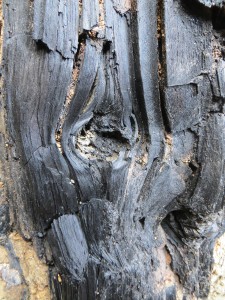We recently told you the story of an ancient, charcoal tree found beneath a pile of ash near Sitka. Scientists hoped tests would help them better understand the area’s rich volcanic history.
Young Blake LaPerriere found this tree during a family outing near a beach on Kruzof Island, west of Sitka.

The trunk and branches were charred as they were buried in hot volcanic ash and debris thousands of years ago. But they remained upright and became visible as ocean waves washed away some of the surrounding material.
Forest Service Geologist Jim Baichtal took samples and sent them off to a lab. The results came up with an approximate date: 13,180 years ago.
Baichtal says that generally corresponds to earlier tests on other ancient items found in the ash area. But those results were in question. These aren’t.
“This has low probability of any kind of contamination and it’s definitely contained in the flow. And you can see from the deposit that there were a couple different surges of that eruption. So you know this tree was living on the landscape and got encased in this very, very hot pumice ash at the time of the eruption,” he says.
Hear our first report about this tree.
The tree age provides a firm date for the explosion from Crater Ridge, a cone near Mount Edgecumbe, the region’s most visible volcano.
“There was a relatively large eruption that blanketed a good portion of Southeast Alaska with volcanic ash,” he says.
Baichtal says about 2 ½ inches covered much of Baranof Island, parts of Glacier Bay and as far east as Juneau.
So anytime it’s found, it dates what’s above or below. (Read a CoastAlaska report on more Southeast volcanos and lava flows.)
The same ash layer has also been found in Sitka Sound, a large ocean bay next to the volcanic area. That’s no surprise. But it was in layers of fresh-water sediments.
“We know that Sitka Sound itself was elevated above its present location and (was) a non-marine environment. It had a fresh-water lake in it,” Baichtal says.
In fact, it was almost 200 feet higher than it is today. Baichtal says that’s due to weight and pressure from advancing and retreating ice-age glaciers.
Tests also established the tree as a Sitka Spruce, which of course, grow in groups.
Does that mean there are more charcoal trees under the ash?
“Without a doubt. There was a forest growing there that just was rapidly buried.”
Baichtal says tests on the tree revealed nothing earth-shattering. But, like so much in science, it added information that will help the experts shape a better picture of Alaska’s past.
Ed Schoenfeld is Regional News Director for CoastAlaska, a consortium of public radio stations in Ketchikan, Juneau, Sitka, Petersburg and Wrangell.
He primarily covers Southeast Alaska regional topics, including the state ferry system, transboundary mining, the Tongass National Forest and Native corporations and issues.
He has also worked as a manager, editor and reporter for the Juneau Empire newspaper and Juneau public radio station KTOO. He’s also reported for commercial station KINY in Juneau and public stations KPFA in Berkley, WYSO in Yellow Springs, Ohio, and WUHY in Philadelphia. He’s lived in Alaska since 1979 and is a contributor to Alaska Public Radio Network newscasts, the Northwest (Public Radio) News Network and National Native News. He is a board member of the Alaska Press Club. Originally from Cleveland, Ohio, he lives in Douglas.




